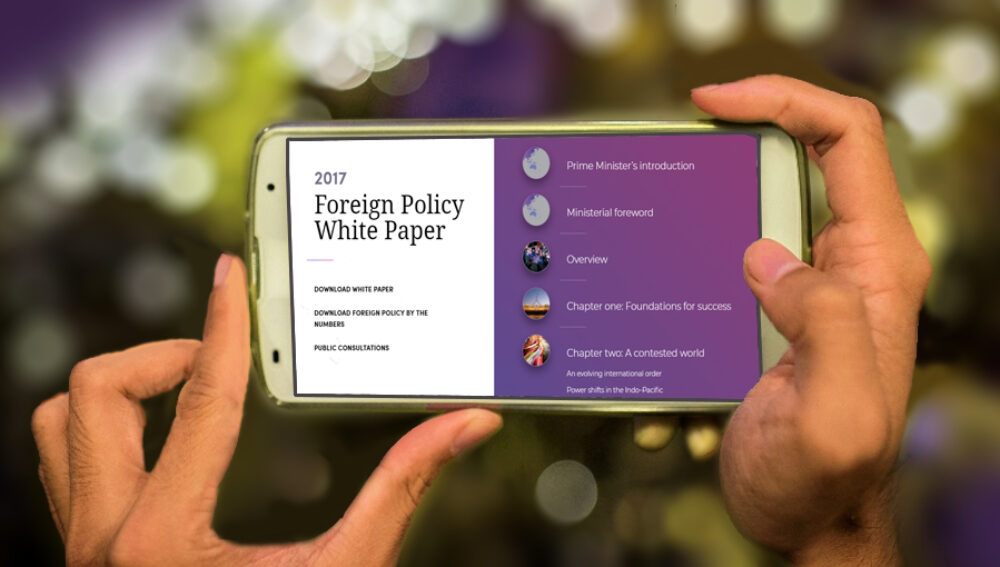In November 2017, the Australian government released its Foreign Policy White Paper to a flurry of interest and speculation as to how Australia will chart a clear course in an increasingly complex world. Scholars, practitioners and policymakers alike offered their views on the outlined economic, defence, national security and diplomatic interests. Critiques include claims the government is ‘clinging to the past as the rest of the world moves on’, with the white paper itself offering ‘more wishful thinking than concrete ideas’.
The Quandary of Digital Diplomacy
One area that has received relatively less attention, but is nevertheless a significant change from the previous white paper, is that of digital diplomacy. While mentioned only once in the entire document, the concepts and ideas that feed into digital diplomacy are nevertheless woven into both the key pressures Australia faces and the identified potential ways forward.
Here lies the quandary: the Australian government recognises the importance of digital diplomacy; it has one of only three ambassadors for cyber or digital affairs (including Denmark and most recently France). The white paper even established that the Australian government ‘will continue to invest in its people to ensure the Australian Public Service has the right digital skills – including employees with technical expertise and investing in staff to develop the skills they need to engage in digital diplomacy’. Yet without a clear mandate for how Australia will address these concerns, and the requisite budgetary support for these initiatives, how the government can best deal with increasing geopolitical instability will remain an elusive concept rather than a practical goal.
Acceptance without Engagement
Part of the disconnect between understanding the importance of digital diplomacy for Australia’s international engagement and achieving the aims of a technologically advanced power relates to a culture of acceptance without engagement. Research has established that social media is an increasingly important tool of digital diplomacy. Over ninety percent of UN member states have a Twitter account, and diplomats are turning to Whatsapp in place of text messages for encrypted communication.
Yet the significance of social media platforms such as these is often dismissed because their structure can produce simplistic and overly negative engagement between users. Even when pitching Australia’s Digital Media Strategy 2016-2018, Australian Minister for Foreign Affairs Julie Bishop blogged that ‘having a Twitter account is however not the same as influence: 140 characters cannot replace human interaction, patience, and negotiating quietly behind closed doors. Twitter doesn’t know when it’s better to say nothing and listen, rather than say too much’. If social media continues to be understood as an entity operating of its own accord, rather than a communication tool central to current and future diplomatic practice, there is a lost opportunity to extend the robustness of Australia’s regional and international digital diplomacy.
Social Media and Future Geopolitical Complexity
The urgent need to develop stronger digital diplomacy practice as part of Australia’s foreign policy goals is even more acute given the complex geopolitical environment the state currently finds itself in. Consider US President Donald Trump’s Twitter rebukes to China over its handling of the North Korea nuclear issue. Trump’s tweet that ‘China has done little to help!’ almost derailed US Secretary of State Rex Tillerson’s March 2017 meeting with the Chinese foreign ministry. The swinging between hostility and friendliness in US-China relations, illustrated by Trump’s Twitter stream, has consequences not just for these two states but for Australia as well. Australia is moving increasingly towards becoming the ‘meat in the sandwich of a potential US-China confrontation’ over trade agreements, the South China Sea and recognition of Taiwan.
Even more so, the increasing coordinated and sustained interference by foreign governments in electoral processes necessitates not only a persistent monitoring of the kind of information being circulated on social media, but also having the technological capacity to evaluate its origins. The white paper has indeed indicated this is of concern to the Australian government, situated within the broader security implications of technological change: terrorism, military and cyber threats. Yet the white paper also establishes the importance of Australia having the capabilities to ‘dispel misconceptions and ensure our voice is heard when new and traditional media are used to sow misinformation or misrepresent Australian policies’.
Here the aforementioned disconnect is evident: recognition that social media is changing the conventional nature of influence, and thus state interest, while the strategic importance of such technology is largely subsumed under the heading ‘soft power’, towards the end of the document. As Susan Harris Rimmer points out, it does feel ‘like an afterthought’. Unless there is greater investment in digital diplomacy and technological capacity as a stand-alone facet of statecraft, Australia will face being left behind on the international stage and more and more buttressed by digital winds of change.








